
Sabal minor, commonly known as the dwarf palmetto, is a small species of palm. It is native to the deep southeastern and south-central United States and northeastern Mexico. It is naturally found in a diversity of habitats, including maritime forests, swamps, floodplains, and occasionally on drier sites. It is often found growing in calcareous marl soil. Sabal minor is one of the most frost and cold tolerant among North American palms.
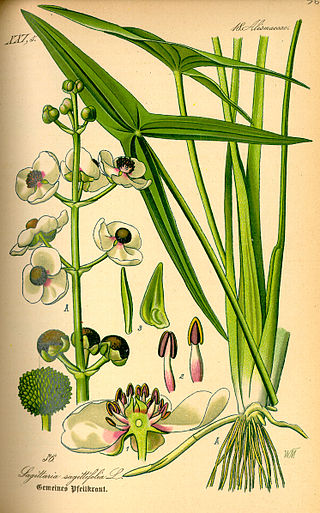
Sagittaria is a genus of about 30 species of aquatic plants whose members go by a variety of common names, including arrowhead, Katniss, duck potato, swamp potato, tule potato, and wapato. Most are native to South, Central, and North America, but there are also some from Europe, Africa, and Asia.

Ditrysinia is a plant genus of the family Euphorbiaceae first described as a genus in 1825. It contains only one recognized species, Ditrysinia fruticosa, the Gulf Sebastian-bush, native to the southeastern United States.

Peltandra, the arrow arums, is a genus of plants in the family Araceae. It is native to the eastern United States, eastern Canada, and Cuba.
- Peltandra sagittifolia - (Michx.) Morong - Spoon flower or the white arrow arum - southeastern US from eastern Louisiana to Virginia
- Peltandra virginica(L.) Schott - Arum arrow - Cuba, Quebec, Ontario, Oregon, California, Washington; eastern US from Maine to Florida, west to Texas, Kansas, and Minnesota
- †Peltandra primaeva – Eocene, Golden Valley Formation, North Dakota, USA

Calopogon tuberosus, the tuberous grass pink, is an orchid native to eastern North America.
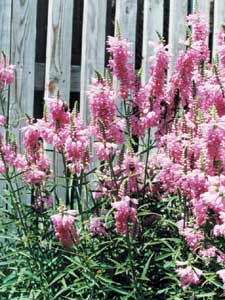
Physostegia, the lionshearts or false dragonheads, is a genus of flowering plants in the family Lamiaceae, native to North America. They are erect rhizomatous herbaceous perennials inhabiting damp, sunny places. They grow up to 2 m (7 ft) tall with purple or pink tubular flowers in racemes in summer.
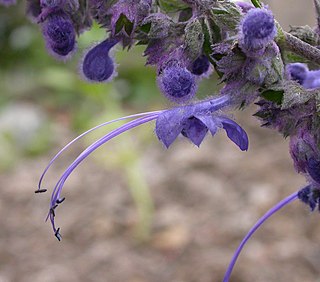
Trichostema is a genus of flowering plants in the family Lamiaceae, which are aromatic herbs or subshrubs. These plants are native to North America. Many plant of this genus which have whorls of small blue flowers are called by the common name bluecurls.

Iva is a genus of wind-pollinated plants in the family Asteraceae, described as a genus by Linnaeus in 1753. Plants of this genus are known generally as marsh elders. The genus is native to North America.

Blephilia, the pagoda plant or wood mint, is a genus of four species of flowering plants in the family Lamiaceae. They are all herbaceous plants native to eastern North America. Blephilia are most often found in open areas, glades, and mesic forests. All species of Blephilia are considered threatened or endangered in some states.

Syngonanthus is a genus of flowering plants in the family Eriocaulaceae. It is native to tropical Africa and to Latin America.

Spermacoce or false buttonweed is a genus of flowering plants in the family Rubiaceae. It comprises about 275 species found throughout the tropics and subtropics. Its highest diversity is found in the Americas, followed by Africa, Australia and Asia.

Reimarochloa is a genus of New World plants in the grass family, native to North and South America including the Greater Antilles. Reimar grass is a common name for this genus.

Symphyotrichum georgianum is a rare species of flowering plant in the Asteraceae, the aster family. Its common name is Georgia aster. It is native to the southeastern United States where it is known from Alabama, Florida, Georgia, North Carolina, and South Carolina. As of 2013, it may be extirpated from the state of Florida.

Sagittaria isoetiformis, common name quillwort arrowhead, is an aquatic plant species native to Cuba and to the southeastern United States.

Spermacoce remota, the woodland false buttonweed, is a species of plant in the Rubiaceae. It is native to the southeastern United States, West Indies, Mexico, Central America and South America. It is naturalized in Taiwan, Southeast Asia, China (Guangdong), India, Sri Lanka, New Guinea, Mauritius and many other oceanic islands.
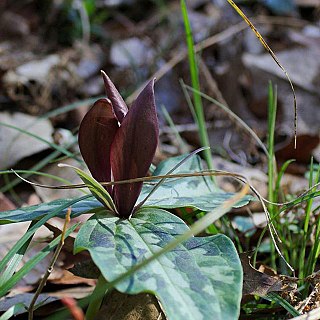
Trillium underwoodii, the longbract wakerobin, is a plant species found only in the southeastern United States.
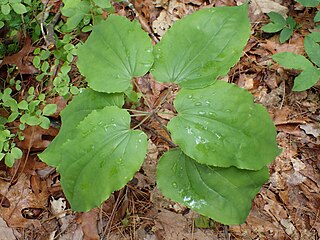
Smilax biltmoreana, common name Biltmore's carrionflower, is a North American plant species native to the south-eastern United States. It is concentrated in the Great Smoky Mountains but with outlying populations in Virginia, North and South Carolina, Tennessee, Kentucky, Georgia, Alabama, and northern Florida.
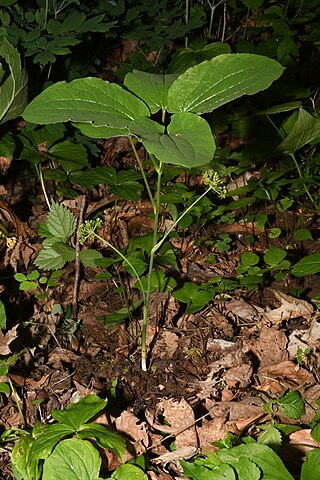
Smilax hugeri, common name Huger's carrionflower, is a North American plant species native to the south-eastern United States. It is found in Mississippi, Alabama, Georgia, Florida, Tennessee, and North and South Carolina.
Smilax pumila, the sarsaparilla vine, is a North American species of plants native to the southeastern United States from eastern Texas to South Carolina.

Syngonanthus flavidulus, common name yellow hatpins, is a flowering plant. It grows in the southeastern United States including Alabama, Florida, Georgia, North Carolina and South Carolina. It is in the Syngonanthus genus and pipewort family Eriocaulaceae. A perennial, it grows to about a foot in height. It grows in flatwoods, prairies, and pond margins. It has very small flowers that bloom February to July and appear as small white buttons and it has shiny leaves. Eugen Otto Wilhelm Ruhland reclassified it from Eriocaulon to Syngonanthus in 1903.



















